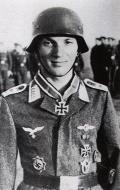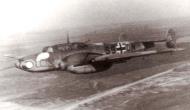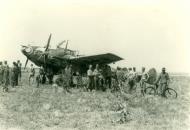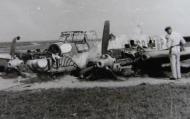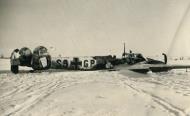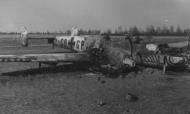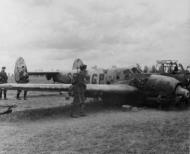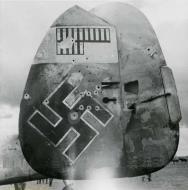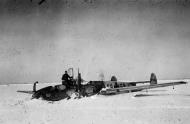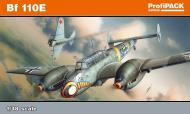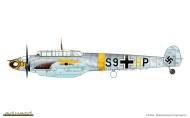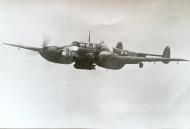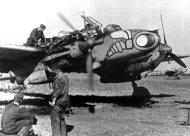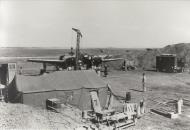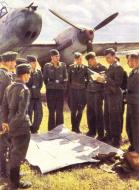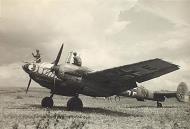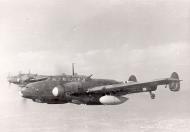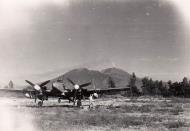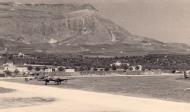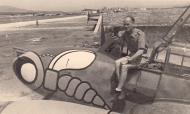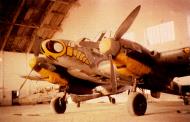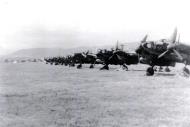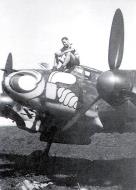5. Staffel II. Gruppe Zerstörergeschwader 1- 5./ZG1
Messerschmitt Bf 110E1 Zerstorer 5./ZG1 (S9EN) WNr 4054 Willi Dibowski n Kurt Meier Konstantinovka Russia July 1942 01
4. Staffel II. Gruppe Zerstörergeschwader 1- 5./ZG1 coded S9+
Messerschmitt Bf-110 D-0 Zerstorer 4./ZG1 (2J+MM) WNr 3188 Stammkennzeichen KE+VF Russia 1942
Photograph Source: Flugzeug Classic 2011-01
Messerschmitt Bf 110E 4./ZG1 Zerstorer (S9+AM) Russia 1942
Messerschmitt Bf 110G 4./ZG1 Zerstorer (S9+EM) Trapani, Sicily 01
Photo 01: Bf 110 heavy fighters of II./ZG1 at Trapani. These aircraft carried out strafing attacks against Allied shipping and landing places in Sicily, during which missions they were escorted by Bf-109s.
Messerschmitt Bf 110G 4./ZG1 (S9+FM) W.Nr 6187 abandoned Monte Corvino Sep 1943 00
Profile 00: Messerschmitt Bf 110G.1 trop S9+FM, W.Nr 6187, of 4./ZG1, Monte Corvino, September 1943 As with the single-engined fighters, the Luftwaffe's twin-engined heavy fighters were also finished in an RLM 74/75/76 scheme. On this example, however, although the uppersurface of the wings would have been finished in a standard splinter pattern, this does not appear to have included the uppersurface of the fuselage which, instead, is virtually solid RLM 74 on the top decking with mottles on the fuselage sides. Although the engines had been removed when the aircraft was photographed, it is thought that the lower panels of the engine cowlings would have been yellow with the tips of the green RLM spinners in the 4. Staffel colour, white, as shown in the profile, or possibly plain green RLM 70. Note the extent of the overpainting on the fuselage which suggests the machine may have had at least two earlier codes.
Messerschmitt Bf 110G 4./ZG1 (S9+FM) W.Nr 6187 abandoned Monte Corvino Sep 1943 01
Photo's 01-03: Zerstorergeschwader 1 was formed and reformed several times in its history, the second formation being raised in Russia in January 1942 from elements of SKG210. In March or April 1943, II./ZG1 converted to the Bf 110G-1 and G-2 and arrived at Monte Corvino in June. This remained the Gruppe's base until August when it was withdrawn from Italy, leaving behind several aircraft which were later photographed by an advance party of the Royal Air Force's 324 Wing on 11 September 1943 which found a total of 21 Bf 110s on the airfield, some of which were G-2 trops. Known as the 'Wespen', or 'Wasp' Geschwader, the aircraft of ZG 1 invariably carried the unit's colourful stylised wasp decoration on the nose. The missing parts of the decoration may be seen on the gun access panels lying on the ground to the right of the photographs above and below. The machines shown here are W.Nr 6232, coded S9+AN with the letter 'A' in red - which was flown by the Staffelkapitän of 5./ZG1 - and S9+FM, W.Nr 6187, of 4./ZG1. Note that the nose panels on S9+AN have come from another aircraft, as shown by the mismatching of the wasp emblem. The Spitfires in the background belonged to 324 Wing.
Messerschmitt Bf 110E 4./ZG1 Zerstorer (S9+HM) Russia 1942
5. Staffel II. Gruppe Zerstörergeschwader 1- 5./ZG1 coded S9+
Messerschmitt Bf 110F Zerstörer 5./ZG1 (S9+IN) 01
Photo 01: In this view of 5./ZG1 Bf 110s, S9+IN has its yellow fuselage band forward of the fuselage code; S9+UP has its band around the rear fuselage. Note the high contrast between the two camouflage colours on the wing surfaces on S9+IN and the aircraft behind it.
Messerschmitt Bf 110G Zerstorer 5./ZG1 (S9+AN) Italy 1943
Photo 01: Bf 110G-2 of II./ZG1 seen in Italy in 1943. Note the yellow tips to the spinners and the yellow lower engine cowlings. An armoured windscreen is fitted.
Messerschmitt Bf 110G 5./ZG1 (S9+AN) W.Nr 6232 abandoned Monte Corvino Sep 1943 01
Photo's 01-03: Zerstorergeschwader 1 was formed and reformed several times in its history, the second formation being raised in Russia in January 1942 from elements of SKG210. In March or April 1943, II./ZG1 converted to the Bf 110G-1 and G-2 and arrived at Monte Corvino in June. This remained the Gruppe's base until August when it was withdrawn from Italy, leaving behind several aircraft which were later photographed by an advance party of the Royal Air Force's 324 Wing on 11 September 1943 which found a total of 21 Bf 110s on the airfield, some of which were G-2 trops. Known as the 'Wespen', or 'Wasp' Geschwader, the aircraft of ZG 1 invariably carried the unit's colourful stylised wasp decoration on the nose. The missing parts of the decoration may be seen on the gun access panels lying on the ground to the right of the photographs above and below. The machines shown here are W.Nr 6232, coded S9+AN with the letter 'A' in red - which was flown by the Staffelkapitn of 5./ZG1 - and S9+FM, W.Nr 6187, of 4./ZG1. Note that the nose panels on S9+AN have come from another aircraft, as shown by the mismatching of the wasp emblem. The Spitfires in the background belonged to 324 Wing.
Messerschmitt Bf 110E Zerstorer 5./ZG1 (S9+BN) Sicily 1943 00
Messerschmitt Bf 110E Zerstorer 5./ZG1 (S9+CN) Kuteinikowo Russia Aug 1942
Messerschmitt Bf 110G 5./ZG1 (S9+AN) W.Nr 6232 abandoned Monte Corvino Sep 1943 01
Photo's 01-03: Zerstorergeschwader 1 was formed and reformed several times in its history, the second formation being raised in Russia in January 1942 from elements of SKG210. In March or April 1943, II./ZG1 converted to the Bf 110G-1 and G-2 and arrived at Monte Corvino in June. This remained the Gruppe's base until August when it was withdrawn from Italy, leaving behind several aircraft which were later photographed by an advance party of the Royal Air Force's 324 Wing on 11 September 1943 which found a total of 21 Bf 110s on the airfield, some of which were G-2 trops. Known as the 'Wespen', or 'Wasp' Geschwader, the aircraft of ZG 1 invariably carried the unit's colourful stylised wasp decoration on the nose. The missing parts of the decoration may be seen on the gun access panels lying on the ground to the right of the photographs above and below. The machines shown here are W.Nr 6232, coded S9+AN with the letter 'A' in red - which was flown by the Staffelkapitn of 5./ZG1 - and S9+FM, W.Nr 6187, of 4./ZG1. Note that the nose panels on S9+AN have come from another aircraft, as shown by the mismatching of the wasp emblem. The Spitfires in the background belonged to 324 Wing.
Messerschmitt Bf 110E Zerstorer 5./ZG1 (S9+DN) Russia 1942
Messerschmitt Bf 110G 5./ZG1 (S9+AN) W.Nr 6232 abandoned Monte Corvino Sep 1943 01
Photo's 01-03: Zerstorergeschwader 1 was formed and reformed several times in its history, the second formation being raised in Russia in January 1942 from elements of SKG210. In March or April 1943, II./ZG1 converted to the Bf 110G-1 and G-2 and arrived at Monte Corvino in June. This remained the Gruppe's base until August when it was withdrawn from Italy, leaving behind several aircraft which were later photographed by an advance party of the Royal Air Force's 324 Wing on 11 September 1943 which found a total of 21 Bf 110s on the airfield, some of which were G-2 trops. Known as the 'Wespen', or 'Wasp' Geschwader, the aircraft of ZG 1 invariably carried the unit's colourful stylised wasp decoration on the nose. The missing parts of the decoration may be seen on the gun access panels lying on the ground to the right of the photographs above and below. The machines shown here are W.Nr 6232, coded S9+AN with the letter 'A' in red - which was flown by the Staffelkapitn of 5./ZG1 - and S9+FM, W.Nr 6187, of 4./ZG1. Note that the nose panels on S9+AN have come from another aircraft, as shown by the mismatching of the wasp emblem. The Spitfires in the background belonged to 324 Wing.
Messerschmitt Bf 110E1 Zerstorer 5./ZG1 (S9+EN) WNr4054 piloted by Willi Dibowski and Kurt Meier Bordfunker belly landed this aircraft near Woroschilowgrad after taking a flak hit from a Russian Tank July 17 1942
Messerschmitt Bf 110G 5./ZG1 (S9+AN) W.Nr 6232 abandoned Monte Corvino Sep 1943 01
Photo's 01-03: Zerstorergeschwader 1 was formed and reformed several times in its history, the second formation being raised in Russia in January 1942 from elements of SKG210. In March or April 1943, II./ZG1 converted to the Bf 110G-1 and G-2 and arrived at Monte Corvino in June. This remained the Gruppe's base until August when it was withdrawn from Italy, leaving behind several aircraft which were later photographed by an advance party of the Royal Air Force's 324 Wing on 11 September 1943 which found a total of 21 Bf 110s on the airfield, some of which were G-2 trops. Known as the 'Wespen', or 'Wasp' Geschwader, the aircraft of ZG 1 invariably carried the unit's colourful stylised wasp decoration on the nose. The missing parts of the decoration may be seen on the gun access panels lying on the ground to the right of the photographs above and below. The machines shown here are W.Nr 6232, coded S9+AN with the letter 'A' in red - which was flown by the Staffelkapitn of 5./ZG1 - and S9+FM, W.Nr 6187, of 4./ZG1. Note that the nose panels on S9+AN have come from another aircraft, as shown by the mismatching of the wasp emblem. The Spitfires in the background belonged to 324 Wing.
Messerschmitt Bf 110G2 Zerstorer 5./ZG1 (S9+FN) Monte Covino, Italy - Summer 1943
One of the units to be withdrawn from the eastern front and activated in Italy in the spring of 1943 was ZG 1. Here, it operated first and foremost as a Jabo (fighter-bomber) unit. For this reason, the aircraft is pictured with bomb racks and dust filters. The yellow theatre markings from the eastern front were supplemented with a white MTO fuselage band that partially obscures the codes. Over the course of 1943, the unit's aircraft also acquired the very distinctive hornet emblem on the nose, associated with the Geschwader's name, 'Hornissen'. This aircraft belongs to the same Staffel as '2N+MN' from profile 'A', but from several months prior, accounting for several marking differences. It is noteworthy how the fuselage codes differed with II./ZG 1: while this aircraft carries 'S9' from Erp.Gr.210, profile 'A' uses '2N' that at different times denoted II./ZG 1 and III./ZG 76. For reasons of different timeframes, there is also a variation in the size of the first part of the codes.
Jednou z jednotek sta�en�ch z v�chodn� fronty a nasazen�ch na ja�e 1943 v It�lii byla i ZG 1. Ta zde p�sobila zejm�na v roli Jabo (st�hac�-bombardovac�). Zobrazen� letoun proto nese pumov� z�v�sn�ky a m� namontov�ny p�skov� filtry. Ke �lut�m identifika�n�m prvk�m v�chodn� fronty v It�lii p�ibyl b�l� pruh identifikuj�c� st�edomo�sk� boji�t� na trupu, kter� z ��sti zakr�v� k�dov� ozna�en�. V pr�b�hu roku 1943 byl na stroj�ch ZG 1 je�t� pou��v�n p�sobiv� embl�m vosy (resp. sr�n�) na p��di, spojen� se jm�nem geschwaderu �Hornissen�.
Additional Information Eduard plastic models - http://www.eduard.com/
Messerschmitt Bf 110E Zerstörer 5./ZG1 (S9+HN) 01-02
Photo's 01-02: Two views of S9+HN, a Bf 110 E of 5./ZG1. Note the extended rear fuselage, and the yellow tactical marking on the lower port wingtip. An armoured windscreen is fitted, and the spinners are capped.
Messerschmitt Bf 110E2 Zerstorer 5./ZG1 (S9+NN) Herbert Kutscha Russia 1942
Messerschmitt Bf 110F Zerstörer 5./ZG1 (S9+SN) 01-02
Photo's 01-02: Two views of belly landed S9+SN of 5./ZG1. The individual aircraft letter 'S' is in red, and the spinners are capped. The first task of ground crew upon reaching a crashed aircraft was to remove the guns, and the Bordfunker's machine gun has already been removed from this machine.
Messerschmitt Bf 110E Zerstorer 5./ZG1 (S9+DN) Russia 1942
Messerschmitt Bf 110E2/U1 Zerstorer 5./ZG1 (S9+UN) W.Nr 2542 Gottfried Seifert Alfred Brandt Bordfunker at Armawir Russia Aug 1942. This aircraft and crew where later lost when a Russian fighter ramed them 15 Kilometers East of Ischerskaja Sep 17 1942
6. Staffel II. Gruppe Zerstörergeschwader 1 - 6./ZG1
Messerschmitt Bf 110E Zerstörer 6./ZG1 (S9+CP) 01
Photo 01: ZG1 aircraft no longer fit for flying duties were cannibalised and used as a supply point for replacement parts. Here II./ZG1 Bf 110s S9+CP and S9+KN can be seen. Note the light coloured rudders, possibly yellow, of the Bf 110 in the central distance.
Messerschmitt Bf 110 E-2 Zerstorer 6./ZG1 (S9+HP) South Russia 1942
Messerschmitt Bf 110 C-7 Zerstorer 6./ZG1 S9+LP W.Nr 3100 had both crew wounded in action South of Ssulazki Alois Sonntag and Bordfunker Christian Messner Russia 1942
Messerschmitt Bf 110G2 Zerstorer I./ZG1 S9+LP 'Red L' Lorient, France 1943
Bf 110 G-2 'Brockenhexe' from 6./ZG 1, with an unusual personal emblem, France, Autumn 1943. This aircraft has the well-known wespe (wasp) emblem on nose, a colourful and popular choice with modellers; standard RLM74/75/76 splinter camouflage, with fuselage mottled in RLM74/75; spinners RLM70 with RLM23 tips; of particular interest is an additional emblem underneath the cockpit depicting a bespectacled witch /crone wearing stripy red and white stockings on a broomstick flying over forest; underneath is the name “Brockenhexe”, which is a type of witch from German folklore.
Reference: LUFTWAFFE im Focus Edition 1 2002. http://www.luftfahrtverlag-start.de/decals.en.html and
http://www.scaleplasticandrail.com/kaboom/index.php/all-things-aviation/everything-else/aftermarket-decals/522-luftwaffe-im-focus-decal-sheet-48002-bf109-fw190-bf110-a-ju88Messerschmitt Bf 110 C-7 Trop. W.Nr 3100 6./ZG 1 Russia 1942
The Bf 110 was, in the C-7, retrofitted with four ETC 50 bomb racks under the wing, and also received dust filters over the air intakes. During their service careers, the darker camouflage schemes were replaced by lighter ones. RLM 70 on the upper surfaces was replaced with what is probably RLM 02. The side surfaces were sprayed with a squiggle of lighter colors. The pattern on individual machines varied from one to the next, and three colors used simultaneously was not uncommon. The artwork here depicts a likely reconstruction.
Additional Information Eduard plastic models - http://www.eduard.com/
Messerschmitt Bf 110E Zerstorer 6./ZG1 (S9+MP) Russia 1942
Aircrew Luftwaffe Alois Sonntag
Asisbiz Database of 1 aerial victories for Alois Sonntag
Date Pilot Name Unit Enemy A/C Type Height Time Location Thursday, November 05, 1942 Alois Sonntag 5./ZG1 Il-2 Sturmovik 400m 10:46 44 843
Hermann (Wilhelm) Dibowski
Units: 7./ZG-26, 5./ZG-1 (8/42 S.U.)
Awards: DK-G(5/19/43), EK 1 & 2, Destroyer Operational Clasp
Known Aircraft: Bf 110E-1 WNr 4054 'S9+EN' (lost)
Remarks: Shot down 13 July, 1942 in his E-1 by a Soviet fighter. One known victory, a Morane in the Ghent/Termonde area, 12 May, 1940. His 2nd, another Morane on 20 May, 1940, no location. A 3rd, his first known Soviet victory, an I-153 on 6 August, 1942. The DK-G Awards List states his Given name as Wilhelm.
Asisbiz database list of 3 aerial victories for Hermann (Wilhelm) Dibowski
Date Pilot Name Unit Enemy A/C Type Height Time Location Sunday, May 12, 1940 Hermann Wilhelm Dibowski 7./ZG26 Morane 08:20 (Ghent-Termonde) Monday, May 20, 1940 Hermann Wilhelm Dibowski 7./ZG26 Morane 19:10 Thursday, August 06, 1942 Hermann Wilhelm Dibowski 5./ZG1 I-153 11:23 10km W Kurgannaya
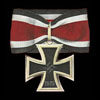
Herbert Kutscha
Units: 5/JG-77, 6/ZG-1 (7/42S.U., II/SKG-210, Sk 12/JG-3, Kdr II/JG-3 (11/44, Stab II/JG-27, III/JG-11
Awards: RK(9/24/42, DK-G(2/23/42, EP(11/3/41, EK 1 & 2, Wound Badge(12/25/44, Fighter Operational Clasp w/Pendant
Known Aircraft: Bf 110, Bf 109F, Bf 109G-6 WNr 411032 (lost 2/10/44, Bf 109G-6 WNr 411048 (lost 2/24/44)
Remarks: His G-6 crashed at Vroomshoop Holland (north van Russenweg) on 10 February, 1944, cause and pilot disposition unknown (DeSwart). Shot down with wounds and bailing safely from his Wk# 411048 on 24 February, 1944, after aerial combat with a P-47 by Quakenbr�ck. In addition to the aerial victories, his ground victories included 41 AC , 41 Tanks, 15 RR engines, 11 AA guns, and 157 trucks. 900 combat missions, including many close support missions. 6 bombers. 14 victories in the West. One known victory, his 1st while in 5/JG-77, a Wellington north of Wangerooge, 14 December, 1939. His 2nd, a Hudson 40 km N of Ameland on 24 February, 1940. His first known Soviet victory, an I-153 on 25 July, 1942. Another I-153 on 9 August, 1942. His 34th, a P-38 on 31 January, 1944. His 35th, a B-17 on 10 February, 1944. A P-51 in the Eisleben area on 2 November, 1944. A P-47 at Monschau-St Vith on 17 December, 1944, while serving in 15/JG-27. Deceased 14 September, 2003.
Asisbiz database list of 22 aerial victories for Herbert Kutscha
Date Pilot Name Unit Enemy A/C Type Height Time Location Thursday, December 14, 1939 Herbert Kutscha 5./JG77 Wellington 15:50 N Wangerooge Saturday, February 24, 1940 Herbert Kutscha 5./JG77 Hudson 09:11 40km N Ameland Saturday, February 24, 1940 Herbert Kutscha 5./JG77 Hudson 09:11 40km N Ameland Sunday, July 26, 1942 Herbert Kutscha 6./ZG1 I-153 20-500m 16:21 88 890 Sunday, August 09, 1942 Herbert Kutscha 6./ZG1 I-153 15:43 05 311 Monday, July 12, 1943 Herbert Kutscha 12./JG3 Spitfire 1500m 11:12 30km S Licata Monday, August 16, 1943 Herbert Kutscha 12./JG3 B-24 Liberator 5000m 12:51 5km S Atella (Basilicata) Thursday, August 19, 1943 Herbert Kutscha 12./JG3 B-17 Fortress II 12:37 Amalfi Coast Friday, August 20, 1943 Herbert Kutscha 12./JG3 P-38 Lightning 2000m 13:28 41 273 (Naples area) Wednesday, August 25, 1943 Herbert Kutscha 12./JG3 B-17 Fortress 6500m 10:50 51 331 Saturday, August 28, 1943 Herbert Kutscha 12./JG3 P-38F Lightning 50-100m 15:55 31 223 Monday, August 30, 1943 Herbert Kutscha 12./JG3 P-38 Lightning 50m 12:20 31 273 (Ischia area) Tuesday, September 07, 1943 Herbert Kutscha 12./JG3 B-24 Liberator Thursday, September 09, 1943 Herbert Kutscha 12./JG3 B-24 Liberator 7200m 13:55 5138 (Calabria) Sunday, December 19, 1943 Herbert Kutscha 12./JG3 B-24 Liberator 6500m 11:52 SE Innsbruck Sunday, December 19, 1943 Herbert Kutscha 12./JG3 B-24 Liberator 6500m 11:52 SE Innsbruck Monday, January 31, 1944 Herbert Kutscha 12./JG3 P-38 Lightning Thursday, February 10, 1944 Herbert Kutscha 12./JG3 B-17 Fortress Monday, February 21, 1944 Herbert Kutscha 12./JG3 B-17 Fortress Hss 7000m 14:35 Raum Holzminden Sunday, July 16, 1944 Herbert Kutscha 4./JG3 Spitfire 350-400m 20:20 AT-12 (St Martin-des-Besaces) Thursday, November 02, 1944 Herbert Kutscha Stab II./JG3 P-51 Mustang 6500m 12:45 LC-9/MD-1-2 Sunday, December 17, 1944 Herbert Kutscha 15./JG27 P-47 Thunderbolt 1200m 11:02 ON u PN (Monschau-St Vith) Herbert Kutscha (1917-2003) served with II./JG 77 at the beginning of the war, but he was soon transferred to 5./ZG 1 equipped with Messerschmitt Bf 110s. During the Battle of France, he shot down a number of aircraft, including a Bf 109 of the air force of neutral Switzerland. Later, he also gained much success on the Eastern Front as a ground attack pilot, partially due to his II./ZG 1 evolving into II.SKG 210. Kutscha's II.Gruppe/SKG 210, under the command of Hptm. Rolf Kaldrack, was specialized in ground attack operations, specifically low level bombing. The Bf 110 was able to move at a faster speed over unfriendly territory than other bombers. Here is where the term "fast bombardment wing" (SKG =Schnellkampfgeschwader)* was coined. Kutscha was awarded the Knight's Cross after his 22nd victory. At that time there were 41 aircraft destroyed on the ground, 41 tanks, 15 locomotives, 11 anti-aircraft guns, and 157 transport vehicles added to his tally. In June, 1943, he received command of 15. Staffel IV./JG 3 "Udet", utilizing single engined fighters. In the summer of 1944, he took control of II./JG 3 in Normandy, and of II./JG 27 by the end of the year. From February, 1945, he commanded III./JG 1 on the Eastern Front. All in all, he flew over 900 sorties, gained 47 kills, six of which were four engined heavies, and 22 of his kills were with the Bf 110. * German Geschwader (squadron) was much bigger unit than RAF or USAF squadron, it was corresponding to USAF wing. Gruppe was equal to USAF Group, Staffel was similar unit as the USAF squadron.
Herbert Kutscha (*1917 + 2003) na zaèátku války sloužil u II./JG 77, ale brzy byl pøevelen k 5./ZG 1 vyzbrojené Messerschmitty Bf 110. Bìhem francouzského tažení sestøelil nìkolikstrojù vèetnì jednoho Bf 109 leteckých sil neutrálního Švýcarska. Pozdìji na východní frontì, kde se z jeho jednotky II./ZG 1 stala II./SKG 210, dosáhl velkých úspìchù i jako bitevníletec. Kutschova II. Gruppe SKG 210 pod velením Hptm. Rolfa Kaldracka se specializovala na bitevní útoky, respektive bombardovací útoky z malých výšek. Nad nepøátelským územím se pøitom Bf 110 pohybovaly vyšší rychlostí než jiné bombardéry. Odtud také pocházel název tohoto útvaru - "rychlá bombardovací eskadra" (SKG =Schnellkampfgeschwader). Kutscha byl po dosažení 22 vítìzství vyznamenán Rytíøským køížem. V té dobì bylo na jeho kontì navíc 41 letadel znièených na zemi, 41 tankù, 15 lokomotiv, 11 protiletadlových kanónù a 157 nákladních vozù. V èervnu 1943 se stal velitelem 15. Staffel IV./JG 3 "Udet" používající jednomotorové stíhaèky. V létì 1944 pøevzal velení II./JG 3 v Normandii a v závìru roku velel II./JG 27. Od února 1945 vedl III./JG 1 na východní frontì. Celkem absolvoval pøes 900 bojových letù, docílil 47 sestøelù, z toho 6 ètyømotorových bombardérù. Na Bf 110 získal 22 vítìzství.
Additional Information Eduard plastic models - http://www.eduard.com/
Luftwaffe pilot Walter Nowotny 258 kills
Luftwaffe pilot Theodor Weissenberger 208 kills
Luftwaffe pilot Heinz Bar 175 kills
Luftwaffe pilot Franz Schall 133 kills
Luftwaffe pilot Rudolf Rademacher 126 kills
Luftwaffe pilot Adolf Galland 104 kills
Luftwaffe pilot Hermann Buchner 58 kills
Luftwaffe pilot Erich Hohagen 50 kills
Luftwaffe pilot Rudolf Sinner 39 kills
Luftwaffe pilot Ernst-Wilhelm Modrow 32 kills
Luftwaffe pilot Richard Altner 25 kills
Luftwaffe pilot Gunther Wegmann 21 kills
Luftwaffe pilot Wolfgang Schenck 18 kills
Luftwaffe pilot Franz Holzinger 10 kills
Luftwaffe pilot Helmut Lennartz 10 kills
Luftwaffe pilot Alfred 'Bubi' Schreiber 9 kills
Luftwaffe pilot Eduard Schallmoser 3 kills
Luftwaffe pilot Wilhelm Batel 1 kills
Luftwaffe pilot Joachim Fingerlos 1 kills
Bibliography: +
- Campbell, Jerry L. Messerschmitt BF 110 Zerstörer in Action. Carrollton, Texas: Squadron/Signal Publications, Inc., 1977. ISBN 0-89747-029-X.
- Caldwell, Donald and Richard Muller. The Luftwaffe over Germany: Defence of the Reich. London: Greenhill Books, 2007. ISBN 978-1-85367-712-0.
- Ciampaglia, Giuseppe. 'Destroyers in Second World War'. Rome: IBN editore, 1996. ISBN 88-86815-47-6.
- Deighton, Len. Fighter: The True Story of the Battle of Britain. London: Pimlico, 1996. ISBN 0-7126-7423-3.
- de Zeng, H. L., D. G. Stanket and E. J. Creek. Bomber Units of the Luftwaffe 1933-1945: A Reference Source, Volume 2. London: Ian Allan Publishing, 2007. ISBN 978-1-903223-87-1.
- Donald, David, ed. Warplanes of the Luftwaffe. London: Aerospace, 1994. ISBN 1-874023-56-5.
- Geust, Carl-Fredrik and Gennadiy Petrov. Red Stars Vol 2: German Aircraft in the Soviet Union. Tampere, Finland: Apali Oy, 1998. ISBN 952-5026-06-X.
- Hirsch, R.S. and Uwe Feist. Messerschmitt Bf 110 (Aero Series 16). Fallbrook, California: Aero Publishers, Inc., 1967.
- Hooton, E.R.Luftwaffe at War; Blitzkrieg in the West: Volume 2. London: Chervron/Ian Allan, 2007. ISBN 978-1-85780-272-6.
- Hooton, E.R. Luftwaffe at War; Gathering Storm 1933-39: Volume 1. London: Chervron/Ian Allan, 2007. ISBN 978-1-903223-71-0.
- Ledwoch, Janusz. Messerschmitt Bf 110 (Aircraft Monograph 3). Gdańsk, Poland: AJ-Press, 1994. ISBN 83-86208-12-0.
- Likso, T. and D. Canak. Hrvatsko Ratno Zrakoplovstvo u Drugome Svjetskom Ratu (The Croatian Airforce in the Second World War). Zagreb, 1998. ISBN 953-97698-0-9.
- Mankau, Heinz and Peter Petrick. Messerschmitt BF 110/Me 210/Me 410: An Illustrated History. Atglen, PA: Schiffer Publishing, 2003. ISBN 0-7643-1784-9.
- Murray, Willamson. Strategy for Defeat: The Luftwaffe 1935-1945. Maxwell AFB, Al: Air Power Research Institute, 1983. ISBN 0-16-002160-X.
- Mackay, Ron. Messerschmitt Bf 110. Wiltshire, UK: The Crowood Press, 2000. ISBN 1-86126-313-9
- Middlebrook, Martin. The Peenemunde Raid: The Night of 17-18 August 1943. Barnsely, UK: Pen & Sword Aviation, 2004. ISBN 1-84415-336-3.
- Munson, Kenneth. Fighters and Bombers. New York: Peerage Books, 1983. ISBN 0-907408-37-0.
- Price, Alfred. Messerschmitt Bf 110 Night Fighters (Aircraft in Profile No. 207). Windsor, Berkshire, UK: Profile Publications Ltd., 1971.
- Savic, Dragan and Boris Ciglic. Croatian Aces of World War II (Osprey Aircraft of the Aces - 49). London: Oxford, 2002. ISBN 978-1-84176-435-1.
- Treadwell, Terry C. Messerschmitt Bf 110(Classic WWII Aviation). Bristol, Avon, UK: Cerberus Publishing Ltd., 2005. ISBN 1-84145-107-X.
- Van Ishoven, Armand. Messerschmitt Bf 110 at War. Shepperton, Surrey: Ian Allan Ltd., 1985. ISBN 0-7110-1504-X.
- The Messerschmitt Bf 110 in Color Profile 1939-1945 John Vasco and Fernando Estanislau by Schieffer Publications. ISBN:0-7643-2254-0
- Wagner, Ray and Heinz J. Nowarra. German Combat Planes: A Comprehensive Survey and History of the Development of German Military Aircraft from 1914 to 1945. New York: Doubleday, 1971.
- Weal, John. Messerschmitt Bf 110 Zerstörer Aces World War Two. London: Osprey, 1999. ISBN 1-85532-753-8.
Magazine References: +
- Airfix Magazines (English) - http://www.airfix.com/
- Avions (French) - http://www.aerostories.org/~aerobiblio/rubrique10.html
- FlyPast (English) - http://www.flypast.com/
- Flugzeug Publikations GmbH (German) - http://vdmedien.com/flugzeug-publikations-gmbh-hersteller_verlag-vdm-heinz-nickel-33.html
- Flugzeug Classic (German) - http://www.flugzeugclassic.de/
- Klassiker (German) - http://shop.flugrevue.de/abo/klassiker-der-luftfahrt
- Le Fana de L'Aviation (French) - http://boutique.editions-lariviere.fr/site/abonnement-le-fana-de-l-aviation-626-4-6.html
- Le Fana de L'Aviation (French) - http://www.pdfmagazines.org/tags/Le+Fana+De+L+Aviation/
- Osprey (English) - http://www.ospreypublishing.com/
- Revi Magazines (Czech) - http://www.revi.cz/
Web References: +
- Wikipedia.org - https://en.wikipedia.org/wiki/Messerschmitt
 Editor for Asisbiz: Matthew Laird Acred
Editor for Asisbiz: Matthew Laird Acred
If you love our website please subscribe to our YouTube video channel
Please donate so we can make this site even better !!



